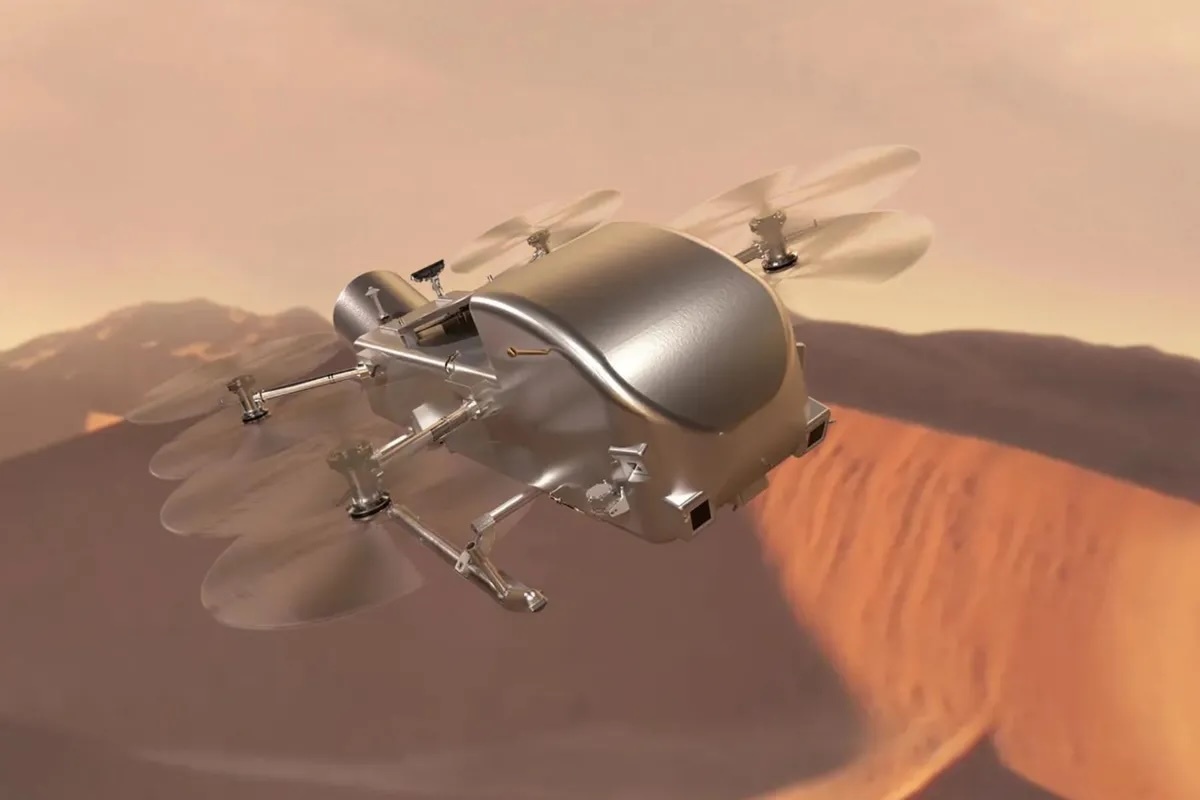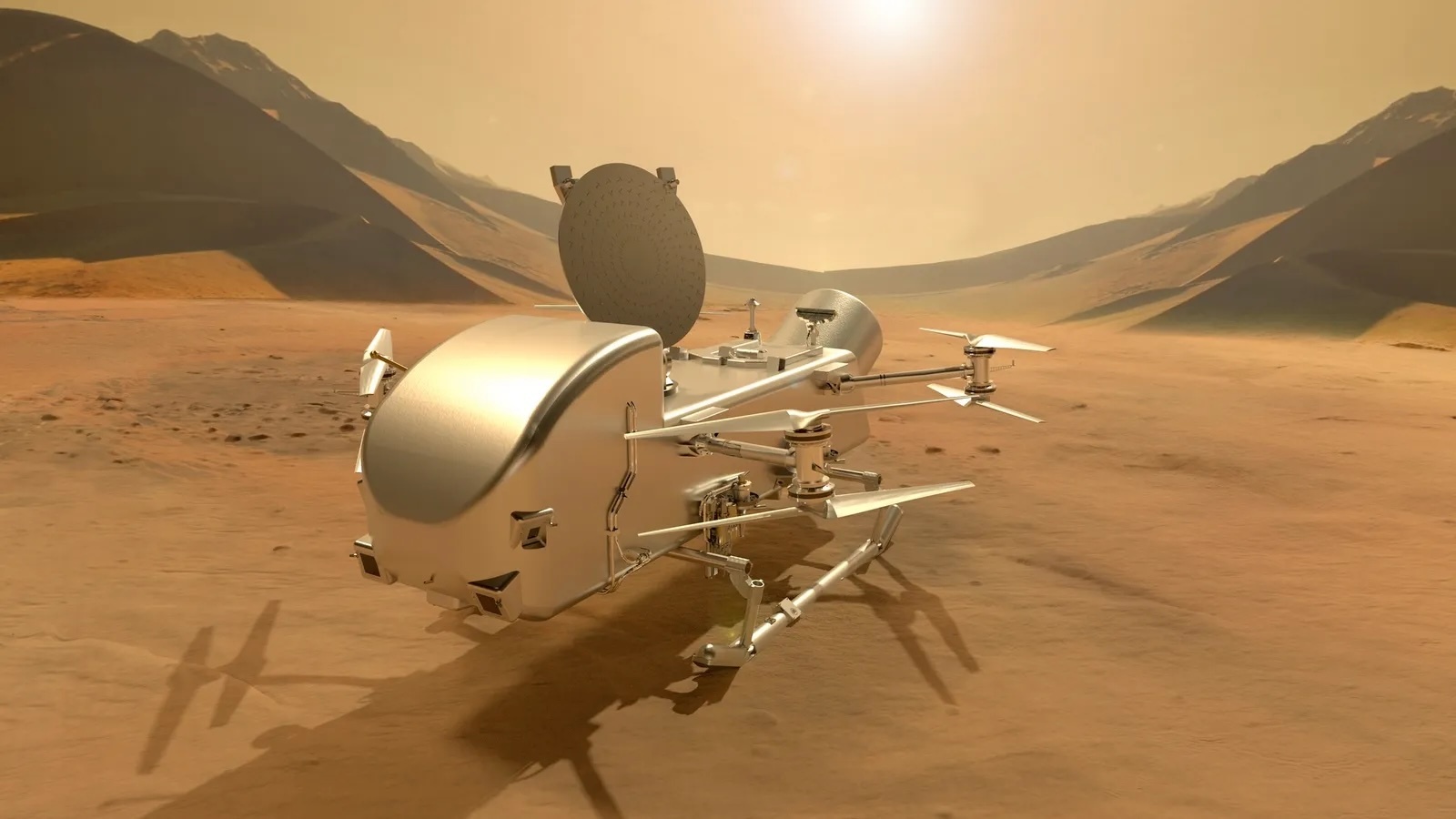NASA has been given the go-ahead to send a flying drone-like lander to explore Titan, the largest of Saturn’s 146 moons.
19.04.2024
The agency has set a July 2028 launch date for its Titan-bound Dragonfly rotorcraft mission.

This artist mockup of Dragonfly soaring over Titan’s dunes has... well, Dunevibes.Image: NASA / Johns Hopkins APL / Steve Gribben
Targeting a July 2028 launch, the agency announced on Tuesday that it can now complete the final design for Dragonfly — a Mars rover-sized rotorcraft that will be used to detect “prebiotic chemical processes common on both Titan and the early Earth before life developed.”
If all goes according to plan, the eight-rotor drone is scheduled to arrive at Titan in 2034, where it will fly to dozens of “promising locations” to characterize the habitability of Titan’s environment and hunt for any signs that life once existed on the organic-rich moon. Titan’s denser atmosphere (around four times that of Earth’s) will aid the rotorcraft to “hop” up to five miles once per full Titan day (16 Earth days).
Dragonfly is expected to cover over 108 miles over the course of its 32-month mission — more distance than all of NASA’s Mars and Earth-Moon rovers combined. NASA estimates the rotorcraft will have a total lifecycle cost of $3.35 billion, roughly twice the expenditure predicted when the project was announced in 2019.
“Dragonfly is a spectacular science mission with broad community interest, and we are excited to take the next steps on this mission,” said Science Mission Directorate associate administrator Nicky Fox in NASA’s press release. “Exploring Titan will push the boundaries of what we can do with rotorcraft outside of Earth.”
Yesterday’s announcement from NASA was made alongside a farewell to Ingenuity, the Mars helicopter that has now sent its final transmission to Earth following its final flight in January.
Quelle: The Verge
----
Update: 24.04.2024
.
NASA confirms Dragonfly mission despite doubled costs

NASA's Dragonfly mission is now scheduled to launch in 2028 and arrive on Saturn's moon Titan in 2034. Credit: NASA/Johns Hopkins APL/Steve Gribben
WASHINGTON — NASA has approved for development a mission to Saturn’s moon Titan despite a cost that has doubled since the agency selected the mission nearly five years ago.
NASA announced April 16 that the Dragonfly mission had passed its confirmation review. Passing the review allows Dragonfly, a nuclear-powered rotorcraft that will travel to various locations on Titan to study the moon’s habitability, to move into full-scale development.
The mission went through part of its confirmation review last fall, but the agency said in November that it would defer a final decision on the mission until the spring, after the release of the fiscal year 2025 budget proposal. NASA also announced then that the launch of the mission, previously scheduled for July 2027, had slipped a year to July 2028.
The confirmation review sets a formal commitment by NASA to the cost and schedule for a mission. NASA said that it confirmed a July 2028 launch for Dragonfly and a total mission cost of $3.35 billion.
That cost is far higher than what NASA approved when it selected Dragonfly in June 2019 as its latest New Frontiers mission. At that time, the mission had a cost cap of $850 million for what NASA designates as Phases A through D, which excludes launch and operations after launch.
NASA, in its announcement about the confirmation, acknowledged the total lifecycle cost, which does include launch and operations, was double from what that earlier estimate. The agency blamed several factors, including replanning due to budget constraints, impacts of the pandemic and supply chain challenges, and an “in-depth design iteration.”
In a statement to SpaceNews April 19, NASA said the costs included in that original cap increased from $1 billion in “real year” dollars, adjusted for inflation, to $2.1 billion, hence the statement that costs had doubled.
“In each of the three fiscal years following Dragonfly’s selection, NASA imposed a cost cap in the current year due to budget constraints. The cumulative impact of these early NASA-directed replans, and another after the Preliminary Design Review (PDR), are responsible for nearly two thirds of the increase in Phase A-D costs,” NASA stated.
“The Dragonfly project also conducted an in-depth design iteration prior to PDR,” NASA added. “The increased costs of that, combined with COVID-driven increases in labor rates and the costs of parts and materials, are responsible for the balance of the increase in Phase A-D costs.”
Those increases are apparent in NASA’s fiscal year 2025 budget proposal. NASA is requesting $434.6 million for Dragonfly in 2025, compared to a projection of $355.5 million for the mission in the agency’s 2024 budget request. For fiscal years 2025 through 2028, NASA is now projecting spending $1.68 billion on Dragonfly, double the projection for the same period in its 2024 proposal.
NASA also anticipates spending more on Dragonfly’s launch. NASA said it will procure a heavy-lift launch vehicle for the mission later this year that will allow Dragonfly to arrive at Titan in 2034. That is the date planned when NASA selected the mission in 2019, despite a two-year delay in its launch since then.
They agency remains supportive about the mission despite the cost challenges. “Dragonfly is a spectacular science mission with broad community interest, and we are excited to take the next steps on this mission,” Nicola Fox, NASA associate administrator for science, said in the statement about Dragonfly’s confirmation. “Exploring Titan will push the boundaries of what we can do with rotorcraft outside of Earth.”
Those cost increases, along with broader budget pressures on NASA in general and its planetary science programs in particular, have implications for future programs. Dragonfly is the fourth mission in the New Frontiers line, after New Horizons, Juno and OSIRIS-REx. NASA had planned to release a call for proposals for the fifth New Frontiers mission in 2023, but has delayed that to no earlier than 2026.
The agency has also warned of likely delays in calls for future missions in the Discovery line of planetary science missions, with lower cost caps than New Frontiers, as well as a line of planetary smallsat missions called SIMPLEx. “We have very few knobs that we can turn in order to respond to these short-term challenges in the budget,” said Lori Glaze, director of NASA’s planetary science division, on delays in future calls for mission proposals during an April 15 town hall.
The budget constraints have also affected NASA’s ability to start work on a future flagship planetary science mission, a Uranus orbiter and atmospheric probe that was recommended by the most recent planetary science decadal survey.
“In the current budget environment, we’re unable to begin the studies and activities we think would be required” to start work on the mission, Glaze said at the town hall. NASA had hoped to start work on that this year or next year. “Right now, the current funding situation does not seem to support that.”
Quelle: SN
